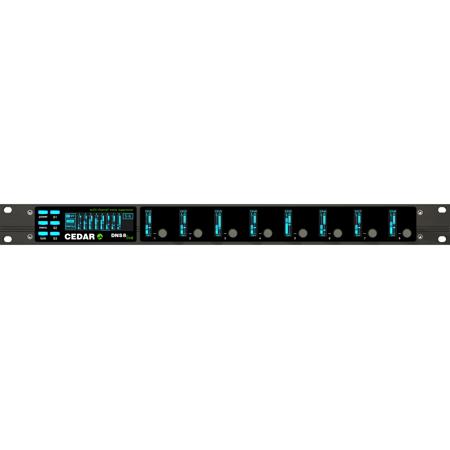
Overview
Compare
Specs
Q&A
Questions & Answers
Shopper : Why Did You Choose This?A. BLAYNE C : It’s like magic in a box. Amazing product.
Reviews about this item
Review Summary
2018-02-27T10:38:06
Rated 5 out of 5
Fantastic
Simply fantastic. Industry standard
William K.
CEDAR Audio DNS 8 Live Specifications
Audio: I/O type
Digital PCM
Audio: Audio formats
AES3 on XLR sockets plus DB25 (AES59 pin-out)
Audio: Sample rates
44.1, 48, 88.2, 96kHz
Audio: I/O resolution
24 bits
Audio: Process resolution
40 bits, floating-point
Audio: Processor power
3.9 GFLOPS
Audio: Latency
<10 samples (0.2ms at 44.1kHz)
Power
90 to 260V AC
50 to 60Hz auto-selectingDC power
12V DC on standard 4-pin connector
Rack Height
1U
Depth
20cm / 7.87"
Weight
6.61lbs / 3kg
UPC Code
192223062665
About CEDAR Audio DNS 8 Live
FEATURED REVIEWS
Fantastic
By William K.
Simply fantastic. Industry standard
When Cedar Audio invented the modern dialogue noise suppressor (the Cedar 'DNS') they designed it for off-line use. It quickly became a standard in post-production, winning an Academy Award and leading the Academy to say of it, "The DNS1000 can be found on virtually all dubbing stages worldwide and has become the tool of choice for removing unwanted noise by re-recording mixers everywhere". Nevertheless, this didn't stop hundreds of them ending Upon location carts, in football stadia and other sports venues, in newsrooms, in live TV studios and in use at specialized live-to-air situations such as The Grammys, the Super Bowl and other very high-profi le events.
So they designed the Cedar DNS 8 Live - the fi rst DNS conceived specifically for live use. Like its predecessors, it offers near-zero latency, 40-bit processing and a fast, intuitive user interface. And it still eliminates traffi c noise, air conditioning, wind, rain, babble and general background noise from audio signals, compensates for unfavourable acoustic conditions and poor microphone placement and will even suppress excessive reverberation.
But its new DNS algorithm now goes much further. Offering up to eight simultaneous channels of dialogue noise suppression, it boasts a simplified '2-knob' approach as well as a detailed editing mode that offers more control than any previous dialogue noise suppressor. This makes it suitable for use in all live situations - not just live-to-air broadcasting, but also live sound in venues such as theatres, concert halls, conferences venues and places of worship.
What's more, it features a new Learn function that calculates the noise content within a signal and determines optimum parameters to attenuate the noise while maintaining the wanted signal. This makes it simultaneously the simplest and fastest to use, yet most effective dialogue noise suppressor ever built.
CEDAR Audio DNS 8 Live Features
- Eight channels of dialogue noise suppression
- A unique DNS algorithm that emphasises rapid setup
- Unique Learn mode for nearly instant, effective results
- A powerful Detail mode ideal for permanent installations
Key Features
- Eight channels of dialogue noise suppression
- A unique DNS algorithm that emphasises rapid setup
- Unique Learn mode for nearly instant, effective results
- A powerful Detail mode ideal for permanent installations